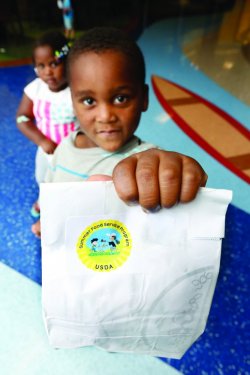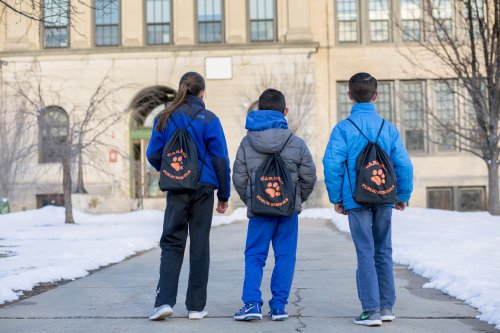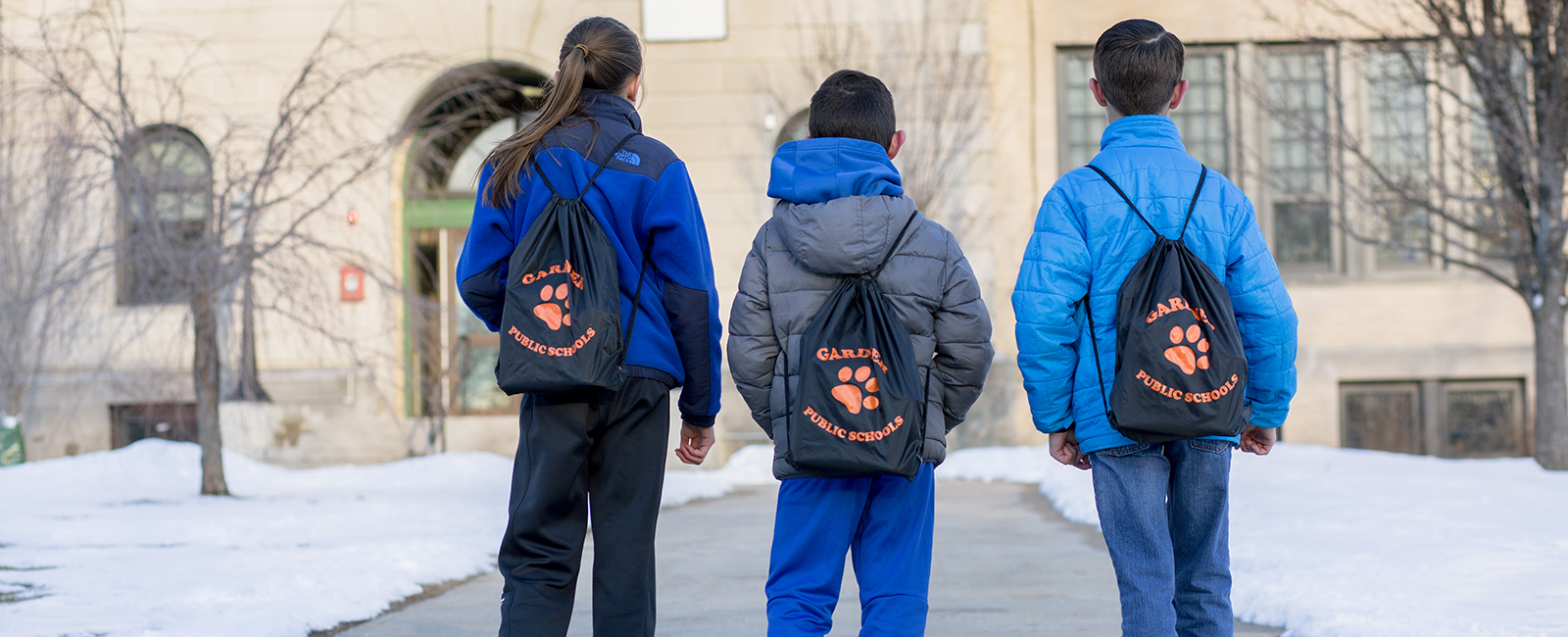Program: Summer, after-school, and weekend meals
Takeaways
Nationwide, approximately 13 million children live in food-insecure households. While school-age children can eat nutritious foods offered through school meal programs, many lack access to healthy food resources outside of school. Summer and Child and Adult Care Food programs, part of the USDA’s child nutrition portfolio, help to address this need. Across the country, weekend meal bag programs also serve to fill this gap and ensure children have access to food when school is not in session.
Hospitals can be a valuable partner in these efforts. Hospital roles include:
- Operating a federally subsidized meal service program for summer months and/or at-risk communities.
- Independently establishing an alternative meal program to ensure children have access to food outside of federally funded programs.
- Supporting feeding programs (with financial or staff resources) run by community-based partners to increase the impact of existing efforts.
Summer, after-school, weekend, and backpack/meal bag programs give low-income children access to nutritious foods when school is not in session. With nearly 13 million children in the United States living in households that experience food insecurity, these programs are an important resource for many families.
The value of these programs to families is substantial. Food insecurity can have significant, long-term repercussions for children. Children who face hunger have increased chance of experiencing poor health. Household food insecurity has been found to influence child development and to adversely affect academic performance and psychosocial outcomes. While school meal programs play a key role in feeding children from low-income and food-insecure households, the need for food resources continues outside of school. Summer meals, after-school meals, and weekend focused programs help alleviate hunger and promote health. Families that receive assistance, such as Supplemental Nutrition Assistance Program (SNAP), still struggle as their benefits are often not enough to meet their needs.
Federally subsidized programs
The United States Department of Agriculture’s (USDA) Summer Food Service Program and the Child and Adult Care Food Program address food insecurity and nutrition outside of its other school-based efforts. These programs involve coordination between the USDA (both federal and regional offices) and state and local authorities. The USDA distributes program funding to state agencies that administer programs and approve program sponsors. Locally-based sponsors oversee program operations and meal sites. For both programs, sponsors can receive federal reimbursement for certain meals and snacks served, provided meals meet the dietary guidelines. Programs are open to children age 18 and under.
Summer Food Service Program

(Arkansas Children’s Hospital)
In communities across the country, local sponsors (namely school authorities and/or community-based organizations) operate the USDA Summer Food Service Program. These organizations give free meals to children when school is out for summer break. Sponsors may serve meals on-site or at approved external sites in the community. Access to sites varies, based on site status as open, enrolled, or camp sites. Sites usually offer one to two meals each day.
Under USDA guidelines, open sites serve areas in which 50 percent or more of children qualify for free or reduced lunch (i.e. family income is at or below 185 percent of poverty level), and enrolled sites serve kids taking part in specific programming (e.g. an activity for which 50 percent or more of kids enrolled in the program qualify for free or reduced lunch). The participation rate for summer meals, less than 3 million daily, is significantly lower than that of the free and reduced lunch program, which served 22 million students daily in 2017. The lower participation rate for summer meals is attributed to less awareness about summer programs and challenges faced by families in accessing meals, such as lack of transportation.
Child and Adult Food Care Program
Under the Child and Adult Care Food Program (CACFP), qualified child care centers, after school programs, and certain institutions can apply to state authorities to operate sites that offer free meals and/or snacks to children age 18 and under. While day care (for children and adults), child care, and afterschool programs predominantly serve as meal sites under CACFP, hospitals may qualify as sites, depending on local circumstances and state program administration. Hospitals may also play a role in supporting existing community programs. For example, a hospital could provide the meals for a community-based afterschool program. Meals may be offered on weekdays and weekends and holidays during the school year. Approved programs can be eligible to operate in the summer via Seamless Summer Option, offering children in the community consistent access to food outside of school, year-round. Reimbursement rates for these programs range from $.88 for snacks to $3.46 for lunch or supper.
The Kids Cafe program, operated by the national hunger relief organization Feeding America is an example of this type of effort. Feeding America network members run more than 6,000 Kids Cafes, which combine healthy snacks and meals with nutrition education. Most Kids Cafes run under federal nutrition programs. The role of Kids Cafe in underserved communities is significant. For instance, Rhode Island Community Food Bank’s two Kids Cafe locations serve 470 children dinner each day.
Planning a hospital-supported summer, weekend or after-school meal program
When planning these programs, hospitals should consider:
- Their capacity to supervise children and the potential need for staff support to do so.
- If and how to make food available for adults who accompany children. Options regularly used include reduced prices for adults or serving adults free meals too. The additional costs incurred for these meals would qualify as community benefit.
- The hospital location: is it readily accessible to the target community?
- Whether other organizations in the community currently host meal programs or are planning to initiate a program. Providing support to community partners, rather than building out a new program, could yield the greatest community impact.
Whether hospitals host programs or support community-based sites, they can offer important support to increase program participation, such as coordinating enrichment activities (e.g. recreational activities and health education) and offering transportation to help families access meal sites. These types of ancillary support may count as community benefit. See the Tax reporting of healthy food access interventions for more information.
Backpack/meal bag programs
Weekend meal bag programs emerged as a means to secure food access for children outside of school in the absence of other efforts. These programs give students, who are identified by school officials as in need, a bag of food to take home for weekends and school vacations. The bags usually contain non-perishable, ready to eat foods such as canned fruits and vegetables, pasta, cereal, granola bars, and crackers that kids can prepare or easily consume without assistance. Bag contents can be assembled at a cost of as little as $2.50-$5.00 per student.

Community-based collaborations and connections to the community’s larger emergency food resources often drive meal bag programs. Feeding America’s network has 160 food banks running its BackPack programs nationwide. In other communities students, school districts, and community organizations run independent programs that provide students with a pre-packed bag of food or give students access to a school-based pantry, from which they can fill their own bag.
Evaluation of backpack/meal bag programs has found parents, teachers, and students report high levels of satisfaction with these initiatives. A 2013 study found 98 percent of parents reported that the program “made a difference in well-being of child,” and the majority of teachers reported observing positive changes in behavior, energy level, and emotional well-being for students participating in programs. In another study, parents reported the program helped them stretch their limited food budget.
Recommendations for hospital participation
Hospitals across the country play an active role in helping at-risk children and youth secure food access outside of school meal programs. Their efforts address a widespread need for healthy food access in the communities they serve. Hospitals should consider support for summer, after-school, and weekend programs as part of their primary prevention strategies for obesity and diet-related disease.
Key roles played by hospitals include providing financial support and staff time to operate on-site meal programs or to support community-based efforts. The specific role that best suits a hospital will vary from community to community. An integral step to supporting these efforts is to first determine what programs, resources, and infrastructure currently operate in your community and what, if any, gaps in service exist. In understanding the current conditions, hospitals will be positioned to make effective investments based on their capacity and specific community needs. Hospitals interested in serving as a USDA program site should contact the state agency that administers these programs to understand how the programs operate in their state.
Examples of hospital roles and participation
Recommendations for hospital participation
Hospitals across the country play an active role in helping at-risk children and youth secure food access outside of school meal programs. Their efforts address a widespread need for healthy food access in the communities they serve. Hospitals should consider support for summer, after-school, and weekend programs as part of their primary prevention strategies for obesity and diet-related disease.
Key roles played by hospitals include providing financial support and staff time to operate on-site meal programs or to support community-based efforts. The specific role that best suits a hospital will vary from community to community. An integral step to supporting these efforts is to first determine what programs, resources, and infrastructure currently operate in your community and what, if any, gaps in service exist. In understanding the current conditions, hospitals will be positioned to make effective investments based on their capacity and specific community needs. Hospitals interested in serving as a USDA program site should contact the state agency that administers these programs to understand how the programs operate in their state.
Examples of hospital roles and participation
Presbyterian Health Care Services, N.M. (Sponsor a USDA Child Nutrition meal site)
![]() Presbyterian Health Care Services
Presbyterian Health Care Services
(Multiple locations in New Mexico)
USDA Child and Adult Care Food Program
Five Presbyterian facilities serve on-site snacks and meals under the USDA’s Child and Adult Care Food and Summer Meal programs. Free meals are available seven days a week between 11am-7pm. meals are also available at a reduced price to adults.
Between the program launch in February 2016 and the end of 2017, Presbyterian served more than 17,000 meals.
University Hospital/UW Health, Wis. (Sponsor a USDA Child Nutrition meal site)
University Hospital, UW Health
Madison, Wisconsin
USDA Summer Meal Program
University Hospital, UW Health initiated summer meal service in 2017, serving meals at two dining locations. Parents were also provided meals, upon request, at no charge.
The program, which operated seven days a week, served 2,000 free meals to children between June and August.
Arkansas Children’s Hospital (Sponsor a USDA Child Nutrition meal site)
![]() Arkansas Children’s Hospital
Arkansas Children’s Hospital
Little Rock, Arkansas
USDA Child and Adult Care Food and Summer Meal Programs
Arkansas Children’s Hospital began serving summer meals in 2013 and now provides sack meals, year-round to children and youth (age 18 and under). Meals are available Monday-Friday from 10 am - 5pm.
Annually, Arkansas Children’s distributes an estimated 21,000 sack meals. The program is particularly helpful for families with hospitalized children, as a convenient way to access food for patient’s siblings.
Brigham and Women’s Faulkner Hospital, Mass. (Sponsor a meal bag program)
![]()
![]() Brigham and Women’s Faulkner Hospital
Brigham and Women’s Faulkner Hospital
Boston, Massachusetts
Fresh Truck
Brigham and Women’s Faulkner Hospital funds and coordinates a meal bag program in conjunction with Fresh Truck, a mobile market. Bags contain fresh fruits and vegetables, recipes, and food and nutrition education information.
Twenty-six families at one school currently receive meal bags. The hospital is currently looking to expand the program to two additional schools.
Heywood Hospital, Mass. (Sponsor a meal bag program)
![]() Heywood Hospital
Heywood Hospital
Gardner, Massachusetts
Gardner Public Schools, Athol Royalston Regional Public School District
Heywood Hospital runs weekend backpack programs for 3rd and 4th grade classes in two school districts, in collaboration with the local rotary clubs. Hospital staff members manage all aspects of the program, from fundraising (to buy food) to packing bags. Bags are packed with food for families, not just individuals (e.g. full-size boxes of cereal).
Heywood’s program with Gardner Public Schools, now in its 4th year, serves 250 students annually, and the Athol program serves 50 students. The hospital also created a toolkit to support program replication, which has been used to establish a similar independent program in Winchendon, MA.
CaroMont Health and CaroMont Regional Medical Center, N.C. (Sponsor a meal bag program)
CaroMont Health and CaroMont Regional Medical Center
Gastonia, North Carolina
BackPack Weekend Food Program and Gaston County School District
CaroMont Health provides financial support, through its foundation, and staff time to support a backpack food program serving the Gaston County School District. CaroMont Regional Medical Center partners with one school (58 students) annually and hospital staff assist with packing food bags each week. The entire backpack food program serves more than 40 of the district’s 55 schools.
CaroMont Health established an umbrella agreement with its group purchasing organization that enables the backpack program to purchase food items at bulk rates. A hospital dietitian works closely with the BackPack Weekend Food Program coordinator to plan menus for elementary, middle, and high school students, to ensure that the weekend food meets their dietary requirements.
St. Vincent/Ascension, Ind. (Sponsor a meal bag program)
St. Vincent/Ascension
Indiana - multiple locations
Starting in 2018, St. Vincent/Ascension facilities will launch an effort to provide eligible students with a weekend backpack of nutritious food for the 2017-2018 and 2018-2019 school years. The program launch follows an extensive, year-long planning process. The goal is to reduce the school’s number of families who report feeling food insecure by 5 percent.
St. Vincent is partnering with 17 schools (16 elementary schools and one high school) to either support an existing program or launch a new effort, where no current program exists. Hospitals engage with partners, such as food pantries and grocery stores, to secure food items and are also building relationships with community based organizations and businesses to secure support for long term sustainability.
Reading Hospital/Reading Health System, Penn. (Partner with community organizations to support USDA meal site implementation)
Reading Hospital/Reading Health System
Reading, Pennsylvania
Reading School District Re-Design Reading
Reading Hospital was a partner in efforts to create a summer meal site at a public housing complex, next to a community health clinic. The hospital contributed funding to upgrade a picnic pavilion to meet USDA requirements.
This summer meal site is one of two mobile sites in Reading, and operates adjacent to a health clinic. The meals incorporated fresh local produce, and the clinic offered free screenings and wellness and nutrition programs to children and families.
Learn more
- Health care, hunger relief organizations, and food service management collaborated to create an implementation guide, Serving Summer Meals in Health Care Institutions: An Implementation Guide, to assist hospitals in planning and implementing USDA Summer Meal Food Programs. This guide includes multiple examples of programs from across the country.
- Hunger Free Colorado has a toolkit to help organizations start and run backpack/bag meal programs. The guide includes tips for assessing needs, engaging the school community, sample menus and menu planning considerations, opt-in/out letters to parents, and survey templates.
- The USDA’s Summer Food Service Program Toolkit is a comprehensive guide to starting and operating a summer food service program. The toolkit covers policy and administration, nutrition guidelines, site requirements, and partnerships and includes information on the state agencies that administer programs.
- The Food Research & Action Center’s Afterschool Meals Fact Sheet provides an overview of after-school meal programs, including details on meal reimbursement and how to get started.
- Michigan State University’s Center for Regional Food Systems created a guide for purchasing local food for the Child and Adult Care Program. Called Local Food for Little Eaters, the guide focuses on early child care, however, the topics covered apply across programs. Topics include purchasing through multiple/different channels (broadline distributor, food hub or cooperative, directly from farmer), procurement documentation worksheets, and best practice examples.
- Feeding America’s 2012 report, Understanding Feeding America Elementary School Based Pantries, describes the different models of school pantries, the pros and cons of each model for schools and families, and program considerations.
- The USDA Economic Research Service report, Children’s Food Security and USDA Child Nutrition Programs, includes data on food insecurity and explains how the USDA’s programs support food security and positive health and academic outcomes for children.
